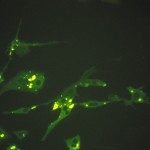Link to Pubmed [PMID] – 21106742
J. Virol. 2011 Feb;85(4):1747-56
Hantaviruses, the causative agents of two emerging diseases, are negative-stranded RNA viruses with a tripartite genome. We isolated two substrains from a parental strain of Puumala hantavirus (PUUV-Pa), PUUV-small (PUUV-Sm) and PUUV-large (PUUV-La), named after their focus size when titrated. The two isolates were sequenced; this revealed differences at two positions in the nucleocapsid protein and two positions in the RNA-dependent RNA polymerase, but the glycoproteins were identical. We also detected a 43-nucleotide deletion in the PUUV-La S-segment 5′ noncoding region covering a predicted hairpin loop structure that was found to be conserved among all hantaviruses with members of the rodent subfamily Arvicolinae as their hosts. Stocks of PUUV-La showed a lower ratio of viral RNA to infectious particles than stocks of PUUV-Sm and PUUV-Pa, indicating that PUUV-La replicated more efficiently in alpha/beta interferon (IFN-α/β)-defective Vero E6 cells. In Vero E6 cells, PUUV-La replicated to higher titers and PUUV-Sm replicated to lower titers than PUUV-Pa. In contrast, in IFN-competent MRC-5 cells, PUUV-La and PUUV-Sm replicated to similar levels, while PUUV-Pa progeny virus production was strongly inhibited. The different isolates clearly differed in their potential to induce innate immune responses in MRC-5 cells. PUUV-Pa caused stronger induction of IFN-β, ISG56, and MxA than PUUV-La and PUUV-Sm, while PUUV-Sm caused stronger MxA and ISG56 induction than PUUV-La. These data demonstrate that the phenotypes of isolated hantavirus substrains can have substantial differences compared to each other and to the parental strain. Importantly, this implies that the reported differences in phenotypes for hantaviruses might depend more on chance due to spontaneous mutations during passage than inherited true differences between hantaviruses.

